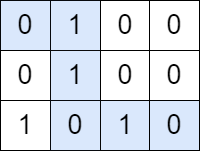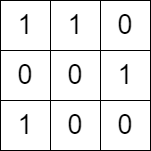Welcome to Subscribe On Youtube
2510. Check if There is a Path With Equal Number of 0’s And 1’s
Description
You are given a 0-indexed m x n binary matrix grid. You can move from a cell (row, col) to any of the cells (row + 1, col) or (row, col + 1).
Return true if there is a path from (0, 0) to (m - 1, n - 1) that visits an equal number of 0's and 1's. Otherwise return false.
Example 1:

Input: grid = [[0,1,0,0],[0,1,0,0],[1,0,1,0]] Output: true Explanation: The path colored in blue in the above diagram is a valid path because we have 3 cells with a value of 1 and 3 with a value of 0. Since there is a valid path, we return true.
Example 2:

Input: grid = [[1,1,0],[0,0,1],[1,0,0]] Output: false Explanation: There is no path in this grid with an equal number of 0's and 1's.
Constraints:
m == grid.lengthn == grid[i].length2 <= m, n <= 100grid[i][j]is either0or1.
Solutions
-
class Solution { private int s; private int m; private int n; private int[][] grid; private Boolean[][][] f; public boolean isThereAPath(int[][] grid) { m = grid.length; n = grid[0].length; this.grid = grid; s = m + n - 1; f = new Boolean[m][n][s]; if (s % 2 == 1) { return false; } s >>= 1; return dfs(0, 0, 0); } private boolean dfs(int i, int j, int k) { if (i >= m || j >= n) { return false; } k += grid[i][j]; if (f[i][j][k] != null) { return f[i][j][k]; } if (k > s || i + j + 1 - k > s) { return false; } if (i == m - 1 && j == n - 1) { return k == s; } f[i][j][k] = dfs(i + 1, j, k) || dfs(i, j + 1, k); return f[i][j][k]; } } -
class Solution { public: bool isThereAPath(vector<vector<int>>& grid) { int m = grid.size(), n = grid[0].size(); int s = m + n - 1; if (s & 1) return false; int f[m][n][s]; s >>= 1; memset(f, -1, sizeof f); function<bool(int, int, int)> dfs = [&](int i, int j, int k) -> bool { if (i >= m || j >= n) return false; k += grid[i][j]; if (f[i][j][k] != -1) return f[i][j][k]; if (k > s || i + j + 1 - k > s) return false; if (i == m - 1 && j == n - 1) return k == s; f[i][j][k] = dfs(i + 1, j, k) || dfs(i, j + 1, k); return f[i][j][k]; }; return dfs(0, 0, 0); } }; -
class Solution: def isThereAPath(self, grid: List[List[int]]) -> bool: @cache def dfs(i, j, k): if i >= m or j >= n: return False k += grid[i][j] if k > s or i + j + 1 - k > s: return False if i == m - 1 and j == n - 1: return k == s return dfs(i + 1, j, k) or dfs(i, j + 1, k) m, n = len(grid), len(grid[0]) s = m + n - 1 if s & 1: return False s >>= 1 return dfs(0, 0, 0) -
func isThereAPath(grid [][]int) bool { m, n := len(grid), len(grid[0]) s := m + n - 1 if s%2 == 1 { return false } s >>= 1 f := [100][100][200]int{} var dfs func(i, j, k int) bool dfs = func(i, j, k int) bool { if i >= m || j >= n { return false } k += grid[i][j] if f[i][j][k] != 0 { return f[i][j][k] == 1 } f[i][j][k] = 2 if k > s || i+j+1-k > s { return false } if i == m-1 && j == n-1 { return k == s } res := dfs(i+1, j, k) || dfs(i, j+1, k) if res { f[i][j][k] = 1 } return res } return dfs(0, 0, 0) }